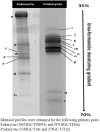Bacaba beverage produced by Umutina Brazilian Amerindians: Microbiological and chemical characterization
- PMID: 26691483
- PMCID: PMC4704630
- DOI: 10.1590/S1517-838246420140964
Bacaba beverage produced by Umutina Brazilian Amerindians: Microbiological and chemical characterization
Abstract
Bacaba chicha is a beverage prepared by the indigenous Umutina people from the bacaba fruit (Oenocarpus bacaba), a purple berry that is rich in fat and carbohydrates, as well as a source of phenolic compounds. In this study, samples of bacaba chicha beverage were collected, and the microbial community was assessed using culture-dependent and -independent techniques. The nutritional composition and metabolite profiles were analyzed, and species belonging to lactic acid bacteria (LAB) and yeasts were detected. The LAB group detected by culture-dependent analysis included Enterococcus hormaechei and Leuconostoc lactis. Polymerase chain reaction and denaturing gradient gel electrophoresis (PCR-DGGE) detected additional Propionibacterium avidum, Acetobacter spp., and uncultured bacteria. Pichia caribbica and Pichia guilliermondii were detected in a culture-dependent method, and Pichia caribbica was confirmed by PCR-DGGE analysis. The pH value of the beverage was 6.2. The nutritional composition was as follows: 16.47 ± 0.73 g 100 mL-1 dry matter, 2.2 ± 0.0 g 100 mL-1 fat, 3.36 ± 0.44 g 100 mL-1 protein, and 10.87 ± 0.26 g 100 mL-1 carbohydrate. The metabolites detected were 2.69 g L-1 succinic acid, 0.9 g L-1 acetic acid, 0.49 g L-1 citric acid, 0.52 g L-1 ethanol, and 0.4 g L-1 glycerol. This is the first study to identify microbial diversity in bacaba chicha spontaneous fermentation. This study is also the starting step in the immaterial record of this Brazilian indigenous beverage prepared from bacaba fruit.
Figures





Similar articles
-
Physicochemical and microbiological characterization of chicha, a rice-based fermented beverage produced by Umutina Brazilian Amerindians.Food Microbiol. 2015 Apr;46:210-217. doi: 10.1016/j.fm.2014.08.009. Epub 2014 Aug 27. Food Microbiol. 2015. PMID: 25475287
-
Microbiological and physicochemical characterisation of caxiri, an alcoholic beverage produced by the indigenous Juruna people of Brazil.Int J Food Microbiol. 2012 May 15;156(2):112-21. doi: 10.1016/j.ijfoodmicro.2012.03.010. Epub 2012 Mar 20. Int J Food Microbiol. 2012. PMID: 22497838
-
Determination of dynamic characteristics of microbiota in a fermented beverage produced by Brazilian Amerindians using culture-dependent and culture-independent methods.Int J Food Microbiol. 2010 Jun 15;140(2-3):225-31. doi: 10.1016/j.ijfoodmicro.2010.03.029. Epub 2010 Mar 27. Int J Food Microbiol. 2010. PMID: 20413168
-
Factors That Affect the Microbiological Stability of Chicha Morada during Its Production on an Industrial Scale: A Review.J Food Prot. 2021 Dec 1;84(12):2151-2158. doi: 10.4315/JFP-21-190. J Food Prot. 2021. PMID: 34347861 Review.
-
Bacaba, Pracaxi and Uxi Oils for Therapeutic Purposes: A Scoping Review.J Oleo Sci. 2024;73(1):11-23. doi: 10.5650/jos.ess23142. J Oleo Sci. 2024. PMID: 38171726
Cited by
-
Differential Modulation of Endophytic Microbiome of Ginger in the Presence of Beneficial Organisms, Pathogens and Both as Identified by DGGE Analysis.Curr Microbiol. 2018 Aug;75(8):1033-1037. doi: 10.1007/s00284-018-1485-1. Epub 2018 Mar 29. Curr Microbiol. 2018. PMID: 29600411
-
A mixed-methods approach to understanding domestic dog health and disease transmission risk in an indigenous reserve in Guyana, South America.PLoS Negl Trop Dis. 2022 Jun 10;16(6):e0010469. doi: 10.1371/journal.pntd.0010469. eCollection 2022 Jun. PLoS Negl Trop Dis. 2022. PMID: 35687596 Free PMC article.
-
Microorganisms present in artisanal fermented food from South America.Front Microbiol. 2022 Sep 8;13:941866. doi: 10.3389/fmicb.2022.941866. eCollection 2022. Front Microbiol. 2022. PMID: 36160237 Free PMC article. Review.
-
Fermented beverages in prehispanic Chile: a comprehensive review of their phytochemistry, traditional medicinal uses, bioactivity, and social aspects.Front Pharmacol. 2024 Nov 21;15:1505873. doi: 10.3389/fphar.2024.1505873. eCollection 2024. Front Pharmacol. 2024. PMID: 39640491 Free PMC article. Review.
-
From forgotten to frontier: vindicating Latin America's indigenous biotechnology.J Ethnobiol Ethnomed. 2025 Jul 24;21(1):52. doi: 10.1186/s13002-025-00808-x. J Ethnobiol Ethnomed. 2025. PMID: 40702499 Free PMC article. Review.
References
-
- Abadio Finco FDB, Kammerer DR, Carle R, et al. Antioxidant activity and characterization of phenolic compounds from bacaba (Oenocarpus bacaba Mart.) fruit by HPLC-DAD-MS(n) J Agricult Food Chem. 2012;60:7665–7673. - PubMed
-
- Aguiar F, Menezes V, Rogez H. Spontaneous postharvest fermentation of açai (Euterpe oleracea) fruit. Postharv Biol Technol. 2013;86:294–299.
-
- Almeida EG, Rachid CCTC, Schwan RF. Microbial population present in fermented beverage “cauim” produced by Brazilian Amerindians. Inter J Food Microbiol. 2007;120:146–151. - PubMed
-
- AOAC - Association of Official Analytical Chemist . Official Methods of Analysis of the Association of Official Analytical Chemist. 17th ed. AOAC; Washington; 2000.
-
- Barata A, Malfeito-Ferreira M, Loureiro V. The microbial ecology of wine grape berries. Inter J Food Microbiol. 2012;153:243–259. - PubMed
Publication types
MeSH terms
Substances
LinkOut - more resources
Full Text Sources
Miscellaneous
